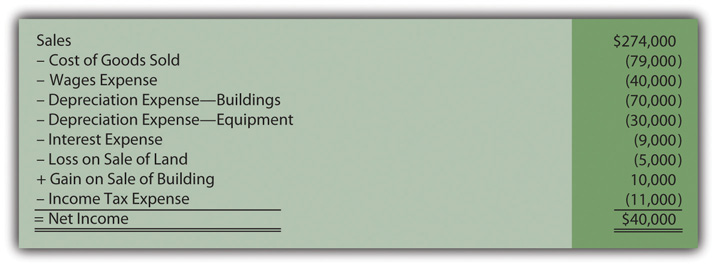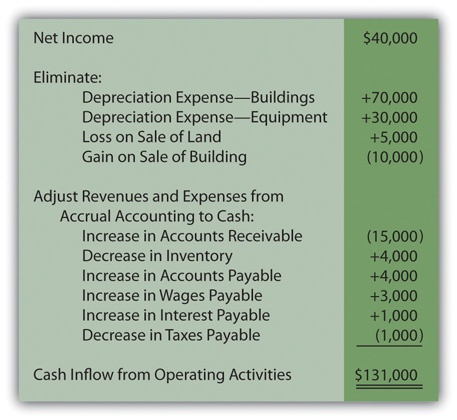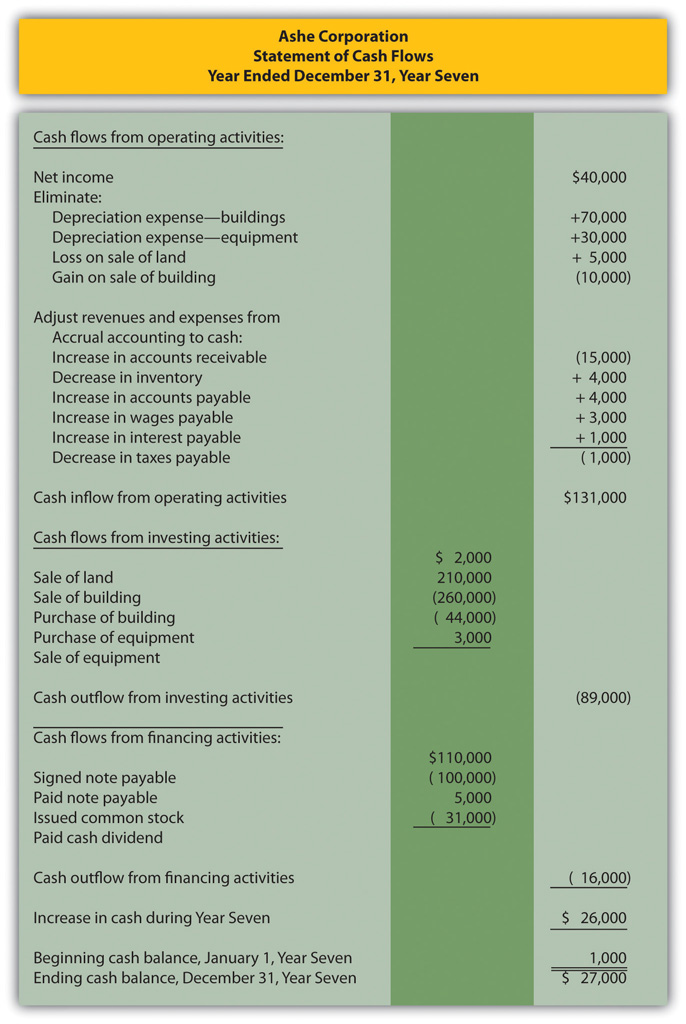This is “Appendix: Comprehensive Illustration—Statement of Cash Flows”, section 17.5 from the book Business Accounting (v. 2.0). For details on it (including licensing), click here.
For more information on the source of this book, or why it is available for free, please see the project's home page. You can browse or download additional books there. To download a .zip file containing this book to use offline, simply click here.
17.5 Appendix: Comprehensive Illustration—Statement of Cash Flows
The Creation of a Complete Statement of Cash Flows
Question: All three sections of the statement of cash flows are presented in this chapter but in separate coverage. Now, through a comprehensive illustration, these categories will be combined into a formal and complete statement.
The following information has been uncovered within the internal records maintained by the Ashe Corporation for Year Seven. The company is a small organization that was incorporated several years ago in the western part of North Carolina.
A few of the significant financial events that occurred during the current year are as follows:
- Land that had cost Ashe $7,000 several years ago was sold to an outside buyer.
- A building was also sold but for $210,000 in cash. This property had an original cost of $230,000. Accumulated depreciation to date on this building was $30,000. This building was replaced with a new purchase made for cash during the year.
- Equipment was purchased for $44,000 in cash to replace other equipment that was sold at the beginning of the year.
- Additional cash of $110,000 was borrowed on a note payable.
- Common stock was issued to an investor for cash of $5,000.
- A cash dividend was declared and paid to the owners near the end of the year.
The accountant for the Ashe Corporation is now attempting to prepare the company’s first complete set of financial statements as part of an application for a new loan. As part of this process, the accountant has created informal balance sheets (Figure 17.26 "Ashe Corporation—Beginning and Ending Balance Sheets for Year Seven") and an income statement (Figure 17.27 "Ashe Corporation—Income Statement for Year Ended December 31, Year Seven").
Figure 17.26 Ashe Corporation—Beginning and Ending Balance Sheets for Year Seven

Figure 17.27 Ashe Corporation—Income Statement for Year Ended December 31, Year Seven

A statement of cash flows is now needed for the Ashe Corporation. As shown in Figure 17.26 "Ashe Corporation—Beginning and Ending Balance Sheets for Year Seven", cash increased from $1,000 to $27,000 during the course of this year. That $26,000 change should be explained. How does a company construct an entire statement of cash flows? Application of the indirect method for presenting operating activities is so prevalent that company officials have decided to use it.
Operating Activities
Answer:
In both the direct and indirect methods, net cash flows from operating activities are derived by following several specific steps:
- Start with net income, either the balance for the period (the indirect method) or the income statement as a whole (the direct method). Because the indirect method is being used here, the preparation of the operating activities section begins with Ashe Corporation’s reported net income of $40,000 (from Figure 17.27 "Ashe Corporation—Income Statement for Year Ended December 31, Year Seven").
- Remove noncash expenses. Here, depreciation must be eliminated. This year, the reported amount is $70,000 (buildings) and $30,000 (equipment). As expenses, depreciation is a negative within net income. To remove these two negative amounts, they are added back to the net income figure. Negatives are removed by the inclusion of a positive.
- Remove nonoperating gains and losses because they relate to either investing activities or financing activities. Consequently, both the loss on the sale of land ($5,000) and the gain on sale of a building ($10,000) are removed. Neither relates to an operating activity. The loss (a negative) is eliminated by an addition to net income while the gain (a positive) is offset by means of a subtraction.
- Convert the remaining revenue and expense balances from accrual accounting to cash accounting by adjusting for changes occurring during the year in related balance sheet connector accounts. The identity of these connector accounts and the amount of each change is reported in Figure 17.28 "Ashe Corporation—Change in Connector Accounts". The increases and decreases were computed from the beginning and ending balance sheets shown previously in Figure 17.26 "Ashe Corporation—Beginning and Ending Balance Sheets for Year Seven".
Figure 17.28 Ashe Corporation—Change in Connector Accounts

The change in each of these six connector accounts—accounts receivable, inventory, accounts payable, wages payable, interest payable, and taxes payable—is factored into the computation of cash flows from operating activities to arrive at the actual effect on cash for the period. In this way, the accrual accounting figures reported on the income statement are changed to their cash equivalents.
Accounts receivable—increase of $15,000. A receivables balance can only rise in this manner when more sales are made on credit than cash is collected. The reduction in the cash received causes the receivable to increase. This decrease in cash collections is reflected by subtracting the $15,000 from net income.
Inventory—decrease of $4,000. The inventory balance dropped, which indicates that less inventory was bought this year than was sold. Fewer purchases take less money, keeping the cash balance high. The decrease in inventory and its impact on cash are reported within operating activities through an addition to net income.
Accounts payable—increase of $4,000. Liabilities increase because more debt is acquired than the amount of cash that is paid. Slowness of payment increases accounts payable but also helps keep the company’s cash balance high. This increase in accounts payable is added to net income as another step in arriving at the cash flows from operating activities.
Wages payable—increase of $3,000; interest payable—increase of $1,000. The balance of both of these accrued liabilities went up during this year. Once again, as with accounts payable, an increase in a liability indicates a reduction in payments. This saving of cash is shown when using the indirect method by adding the increases in wages payable and interest payable to net income.
Taxes payable—decrease of $1,000. A liability goes down because cash payments are made that reduce the obligation. However, those payments also shrink the amount of cash held. This effect is mirrored by subtracted the decrease in the liability from net income.
The steps for determining cash flows generated by operating activities have been completed (using the indirect method), and this part of the statement of cash flows can be prepared as shown in Figure 17.29 "Ashe Corporation—Cash Flows from Operating Activities for Year Ended December 31, Year Seven (Indirect Method)".
Figure 17.29 Ashe Corporation—Cash Flows from Operating Activities for Year Ended December 31, Year Seven (Indirect Method)

As can be seen by comparing Figure 17.29 "Ashe Corporation—Cash Flows from Operating Activities for Year Ended December 31, Year Seven (Indirect Method)" to the company’s income statement (Figure 17.27 "Ashe Corporation—Income Statement for Year Ended December 31, Year Seven"), cash generated by operating activities ($131,000) is considerably higher than the net income reported for that same period ($40,000). Such differences are not uncommon in the business world especially since depreciation is often a large expense that does not require cash.
Investing Activities
After accounting for operating activities, only three asset accounts remain to be examined (along with accumulated depreciation balances where appropriate): land, buildings, and equipment. The accountant analyzes each individually and attempts to recreate the transactions that brought about the various changes during the year.
Land decreased by $7,000 ($21,000 to $14,000). The information provided by the accountant states that land costing $7,000 was sold but does not indicate the amount of cash received. However, the income statement discloses a $5,000 loss on the sale of land. If land costing $7,000 is sold at a loss of $5,000, only $2,000 in cash is received. The journal entry shown in Figure 17.30 "Assumed Journal Entry for Sale of Land" was apparently recorded by Ashe Corporation for this transaction. Land is an asset, so this $2,000 inflow of cash will be reported as an investing activity.
Figure 17.30 Assumed Journal Entry for Sale of Land

Buildings increased by $30,000 ($390,000 to $420,000). According to the introductory information, one building with a cost of $230,000 but a net book value of $200,000 (related accumulated depreciation was identified as $30,000) was sold during this year for $210,000. The company received $10,000 more than net book value which creates the $10,000 gain that appears on the company’s income statement. Because all account balances are known here, the journal entry made by the Ashe Corporation can be replicated in Figure 17.31 "Assumed Journal Entry for Sale of Building". This transaction will be listed as a $210,000 cash inflow within investing activities on the statement of cash flows.
Figure 17.31 Assumed Journal Entry for Sale of Building

The entry made in Figure 17.31 "Assumed Journal Entry for Sale of Building" does not fully explain the monetary change appearing in the buildings account during this period. This sale drops that account from $390,000 to $160,000 (because of the $230,000 reduction in cost). However, the final balance for the year was not $160,000 but rather $420,000, an increase of $260,000. The introductory information does indicate that a new building was acquired as a replacement. Without mention of any other building transaction, the assumption must be made that this asset was acquired for $260,000 through the entry presented in Figure 17.32 "Assumed Journal Entry for Purchase of Building". The cash payment will be disclosed on the statement of cash flows as a $260,000 investing activity outflow.
Figure 17.32 Assumed Journal Entry for Purchase of Building

Equipment increased by $14,000 ($36,000 to $50,000). The information provided by the company’s accountant states that one piece of equipment was purchased during the year for $44,000 in cash. This transaction is recorded in Figure 17.33 "Assumed Journal Entry for Purchase of Equipment" and identifies another cash outflow to be reported within the investing activities.
Figure 17.33 Assumed Journal Entry for Purchase of Equipment

This journal entry does not entirely explain the change that occurred in the equipment account. The beginning balance of $36,000 grew to $80,000 as a result of this $44,000 purchase. Yet, the ending balance was just $50,000. Apparently, during the year, another $30,000 reduction ($80,000 less $50,000) took place. Equipment accounts decrease as the result of a sale or some other type of disposal. Equipment was sold this period; its cost must have been the cause of this $30,000 decrease.
In recording the disposal of a long-lived asset, removal of any related accumulated depreciation is also necessary. For the equipment owned by Ashe Corporation, beginning accumulated depreciation was $17,000—a figure that increased by $30,000 due to the depreciation for that year (to a balance of $47,000). However, the ending accumulated depreciation account shows a balance of only $20,000. Another change in this contra account, a reduction of $27,000 ($47,000 less $20,000), still needs to be explained. This figure is the accumulated depreciation for the equipment that was sold. That balance was removed in recording the disposal of this asset.
Because no gain or loss on the disposal of equipment is reported in the income statement, the amount received must have been equal to the $3,000 net book value of the asset ($30,000 less $27,000). With that assumption, the journal entry shown in Figure 17.34 "Assumed Journal Entry for Sale of Equipment" can be constructed. The $3,000 collection will be reported as a cash inflow from an investing activity.
Figure 17.34 Assumed Journal Entry for Sale of Equipment

All changes in the land, buildings, and equipment accounts have now been examined. Each individual transaction was recreated and the change in cash calculated. The investing activity section of the statement of cash flows can then be prepared in Figure 17.35 "Ashe Corporation—Cash Flows from Investing Activities for Year Ended December 31, Year Seven" based on the information that has been gathered.
Figure 17.35 Ashe Corporation—Cash Flows from Investing Activities for Year Ended December 31, Year Seven

Financing Activities
Only three accounts remain unexamined: notes payable, capital stock, and retained earnings. They are either liabilities or stockholders’ equity accounts and, thus, lead to financing activities.
Notes payable increased by $10,000 ($120,000 to $130,000). The information gathered from the company disclosed the signing of a note payable for $110,000 in cash. The journal entry is made in Figure 17.36 "Assumed Journal Entry for Signing of Note Payable". This transaction is obviously an inflow of that amount of cash that will be reported as a financing activity.
Figure 17.36 Assumed Journal Entry for Signing of Note Payable

According to the beginning and ending balance sheets, notes payable did not actually increase by $110,000 but only by $10,000. Thus, another transaction must have taken place that reduced this liability by $100,000. Except in unusual situations, notes payable only decrease because of cash payments. Because no gain or loss on extinguishment of debt is reported in the income statement, Ashe Corporation must have paid exactly $100,000 to retire that same amount of debt. The journal entry is shown in Figure 17.37 "Assumed Journal Entry for Extinguishment of Note Payable" and the accountant has located another financing activity cash flow (a $100,000 payment).
Figure 17.37 Assumed Journal Entry for Extinguishment of Note Payable

The recording of this second transaction (Figure 17.37 "Assumed Journal Entry for Extinguishment of Note Payable") leads to the appropriate change in notes payable (the $10,000 account increase was created by $110,000 in additional borrowing and a $100,000 decrease payment).
Capital stock increased by $5,000 ($50,000 to $55,000). The information provided by the accountant states that Ashe Corporation issued stock to an investor for $5,000. This contribution created the change seen in this account, which is recorded in Figure 17.38 "Assumed Journal Entry for Issuance of Capital Stock". The business received this money and must report a financing activity cash inflow of $5,000. No other stock transactions are indicated for Ashe Corporation.
Figure 17.38 Assumed Journal Entry for Issuance of Capital Stock

Retained earnings increased by $9,000 ($140,000 to $149,000). This final balance sheet account increased by $40,000 because of the net income earned by Ashe Corporation as reported on its income statement. At the end of the year, this amount is closed into retained earnings. The cash flows relating to net income have already been presented within operating activities.
To create the overall change of $9,000, retained earnings must have also declined by $31,000. As mentioned several times in this textbook, other than net income, retained earnings are changed by virtually only one other event: the distribution of dividends. The information provided by the accountant mentions that a dividend was paid this year. That dividend must have caused the remaining $31,000 drop. Net income of $40,000 and a dividend distribution of $31,000 provide the reported increase in retained earnings of $9,000. The dividend entry is presented in Figure 17.39 "Assumed Journal Entry for Payment of Cash Dividend".
Figure 17.39 Assumed Journal Entry for Payment of Cash Dividend

With this final financing activity, an entire statement of cash flows can be created for the Ashe Corporation in Figure 17.40 "Ashe Corporation—Statement of Cash Flows Year Ended December 31, Year Seven". All the transactions that affected cash during the current period are included within one of the three categories. Investors and other interested parties can gain a complete picture of the cash results of operations as well as the investing and financing decisions made by management. This portrait provides an excellent complement to the income statement, statement of retained earnings, and balance sheet.
Figure 17.40 Ashe Corporation—Statement of Cash Flows Year Ended December 31, Year Seven

Video Clip
(click to see video)Professor Joe Hoyle talks about the five most important points in Chapter 17 "In a Set of Financial Statements, What Information Is Conveyed by the Statement of Cash Flows?".




